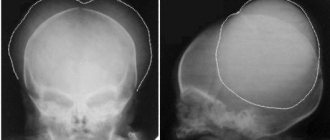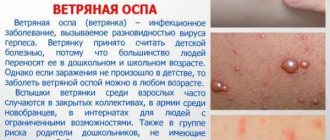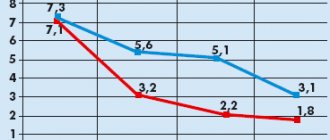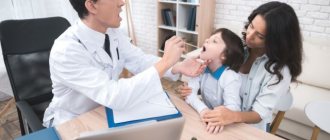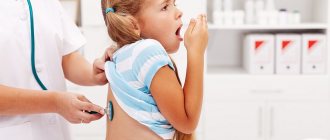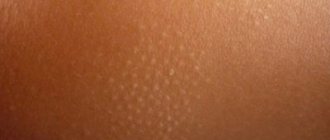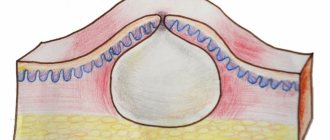Roseola, or sudden exanthema, Boston or three-day fever is an acute viral infectious disease in children aged 6 months to 3-4 years (most often - up to 1 year, practically does not occur in children over 5 years). Roseola disappears within 5-7 days, has a favorable prognosis and forms lifelong immunity. The disease causes virtually no complications; in rare cases, against the background of decreased immunity, microbial otitis media, bronchitis or pneumonia are possible.
Roseola is treated by a pediatrician. Therapy in the vast majority of cases is carried out at home and does not require hospitalization.
Causes
The causative agent of the disease is a certain type of herpes virus, and signs of roseola in a child appear as a consequence of the body’s reaction to this virus. Symptoms and signs of roseola begin to appear only against the background of the presence of several factors.
In the practice of infectious disease doctors, there are cases when the cause of infection with the roseola virus in children occurs as a result of the baby’s contact with the carrier of the pathogen. In addition, roseola does not have a seasonal nature, but unfavorable weather conditions can increase the risk of developing the disease. Especially in the autumn-spring period, when there is a weakening of immunity in children, and the body is most susceptible to various types of infections. During this period, parents are advised to be especially attentive to the physical condition and well-being of their children.
In addition, the following factors can be identified among the causes of roseola in children:
- uncontrolled use of medications, resulting in a decrease in the body’s defenses;
- consequences of the child’s previous chemotherapy sessions;
- presence of cancer and HIV;
- impaired immunity as a result of congenital pathologies.
Doctor's help for roseola
No special treatment is required. The disease is usually mild, and recovery in most cases occurs on its own. Antipyretic medications are used to alleviate the baby’s condition.
Antiviral drugs are rarely prescribed: for severe disease or weakened immunity.
Antibiotics are used for complications to fight bacterial infection.
If the child has seizures, the child is hospitalized and anticonvulsants are prescribed. After stopping the attack and in the future, the baby must be observed by a neurologist.
Pathogens
As mentioned above, the causative agent of roseola symptoms in children is herpes type 6. Since children under one year of age do not have immunity to this disease, they are the ones most susceptible to the development of roseola.
It is important to know that the incubation period can last about two weeks, but with a timely diagnostic examination and timely treatment, symptoms can be completely eliminated within 7 days.
There is evidence that one of the factors in infection entering a child’s body is the airborne route.
How long is the incubation period for roseola?
The causative agent of the disease is the sixth type of herpes virus, which, when it gets on the skin and tissues, causes their damage. By reacting with immune cells, the pathogen provokes the appearance of a characteristic rash. In adults, the virus causes chronic fatigue syndrome, and in children under three years of age - sudden exanthema. How long is the incubation period for roseola? – 3-7 days. Although there are cases when the incubation period reaches 15 days.
Most often, pseudorubella is diagnosed in the spring and autumn.
Symptoms
The development of roseola symptoms in children occurs in stages, and begins with an increase in body temperature. However, all attempts to reduce it using antipyretic drugs and medications do not give the desired result. After some time, the signs of roseola are complemented by inflammation of the respiratory organs and the appearance of a skin rash.
The period of fever in a child can be 3 days. It is interesting that temperatures reaching a critical level of up to 40 degrees can appear suddenly and disappear just as suddenly. The development of the disease worsens the child’s well-being, which is characterized by:
- decreased appetite;
- general weakness of the body;
- enlarged lymph nodes in the occipital region and back of the neck;
- increased pulsation of the fontanel;
- pale skin on the hands;
- the appearance of febrile seizures;
- trembling chin;
- tendency to loose stools;
- the appearance of rhinitis and redness of the throat;
- the appearance of spots on the soft palate or tongue;
- cold feet and hands, despite elevated body temperature;
- the appearance of a skin rash in the form of pink spots with a white border.
If the above symptoms appear, you should immediately call a doctor to avoid possible complications.
Factors that trigger rosacea outbreaks –
The following list of triggers that can lead to rosacea flare-ups was compiled based on clinical research and published by the National Rosacea Society (USA).
| Factors that can cause rosacea flare-ups | ||
| Products - liver, yogurt, sour cream, cheese (except cottage cheese), chocolate, vanilla, soy sauce, yeast (bread is fine), vinegar, eggplant, avocado, spinach, beans and peas, citrus fruits, tomatoes, bananas, red plums, raisins or figs, spicy and too hot foods. Emotional states – stress, anxiety. | Medicines – some analgesics, vasodilators, steroids. Skin care products – cosmetics and hair sprays containing alcohol, witch hazel, fragrance, menthol, peppermint, eucalyptus oil, or any substance that causes redness or burning. Beverages - any alcohol (especially red wine), hot drinks, hot chocolate, coffee or tea. | Weather – exposure to the sun, strong wind, cold, high humidity. Temperature – sauna, hot baths, simple overheating, excessively warm environment. Medical conditions – menopause, cough, caffeine withdrawal syndrome. Exercise stress - active sports, work with a load, work in an incline. |
Importance of various factors –
Below we will divide these factors by strength (from the strongest to the weakest). Next to each factor, you will see the percentage of people for whom this factor was significant and almost certainly led to the development of a rosacea outbreak. This list is based on a survey of more than a thousand patients, and is also published by the National Rosacea Society.
In what percentage of cases do factors lead to exacerbations -
- sun exposure – 81%,
- emotional stress – 79%,
- hot weather – 75%,
- wind – 57%,
- heavy exercise – 56%,
- alcohol consumption – 52%,
- hot baths – 51%,
- cold weather – 46%,
- spicy food – 45%,
- humidity – 44%,
- high body temperature – 41%,
- some skin care products – 41%,
- hot drinks – 36%,
- certain cosmetics – 27%,
- medicines – 15%,
- medical conditions (see above) – 15%,
- some fruits – 13%,
- marinated meat – 10%,
- some vegetables – 9%,
- dairy products – 8%,
- other factors – 24%.
Skin care and cosmetics –
Gentle skin care and effective use of cosmetics can improve the appearance of your skin, but you should use products that are suitable for sensitive skin. Avoid any products that cause burning, redness or irritation. It is worth abandoning chemical and mechanical peeling products. In addition to irritants, components that provoke outbreaks of rosacea include:
- alcohol,
- witch hazel,
- flavorings,
- menthol,
- peppermint,
- Eucalyptus oil.
Try to use products that do not contain fragrances or strong preservatives. Always read the ingredient list carefully. Do not use many different products at once. Before using the product on your face, test it on your neck. In addition, please note that patients with rosacea, especially in winter (as well as in dry air indoors or outdoors), need to regularly use skin moisturizing creams. This will reduce skin irritation and reduce the risk of flare-ups.
Men's shaving and aftershave products – Shaving can be a big challenge for men with rosacea, so one option is to use an electric razor. You should also avoid using any shaving or aftershave lotions or products that contain alcohol, menthol or other irritants. Use gentle aftershave balms to soothe and hydrate your skin.
Sun protection –
Exposure to active solar radiation is the main factor causing flare-ups of rosacea and the appearance of telangiectasia. There are 2 types of damaging sun rays – UVA radiation and UVB radiation. Solar radiation consists of approximately 96.5% radiation of the first type, and 3.5% of the second type. UVA rays penetrate deeper into the skin, they lead to skin aging, the development of melanomas and affect the skin throughout the day.
Despite the fact that UVB rays are small (only 3.5%) they contribute to the development of skin cancer. Patients with rosacea need to choose sun protection products that protect against two types of radiation at once, with an SPF of 15 or higher. Sunscreens with mineral rather than chemical components will have minimal irritating effects on the skin. These components include zinc oxide and titanium dioxide. Apply these products every day when you go outside.
If you plan to stay in intense sun, apply the cream every 2 hours, and also every time immediately after swimming or heavy sweating. But even following these recommendations, you should limit your exposure to the sun in the summer, and try not to stay in the sun for long periods between 10 a.m. and 4 p.m. Our article: Facial Rosacea Causes and Treatment is based on clinical studies published by the National Rosacea Society (USA), and we hope you found it useful!
Sources:
1. Textbook of dermatology “Fitzpatrick's Dermatology” (8th edition), 2. American Academy of Dermatology (USA), 3. National Rosacea Society (National Rosacea Society, USA), 4. “Comparative assessment of the effectiveness of various methods of treating rosacea” (Pearl).
Classification
Roseola in children can occur in the absence or presence of certain symptoms, so the disease is divided into two types.
The danger of an asymptomatic infectious disease is that it is not possible to start treatment in a timely manner, and in addition, the child during this period is a carrier of roseola and can infect other children through contact with them in kindergarten or school.
In the second case, the intensity of roseola symptoms is influenced by a number of important points:
- individual characteristics of the baby’s body;
- associated factors;
- level of the body's defenses (immunity).
When roseola occurs in a simple form, the child’s temperature rises and characteristic rashes appear on the skin. It is noteworthy that after treatment there is no fear of relapse.
As for the flaky form, it is distinguished by a profuse rash in the form of pink spots and blisters that cover the child’s skin, but is not accompanied by itching and does not cause discomfort to the baby.
Erythematous-telangiectatic form -
Clinical features - this type is characterized by either the appearance of persistent erythema (i.e. redness) in the middle third of the face, or frequent but quickly passing attacks of hyperemia. Hyperemia differs from erythema primarily in its duration - it tends to pass quickly, while the severity of redness during hyperemia can be from moderate to very intense. In addition, patients often complain of small blood vessels visible through the skin (telangiectasia), as well as swelling of the face, roughness of the skin or peeling, and a feeling of tightness.
Telangiectasia with rosacea: photo
In this form, most patients associate a sharp deterioration in their condition with exposure to irritating factors - drinking hot drinks, spicy food, exposure to the sun, heat, etc. As a rule, these patients have sensitive skin and therefore, in response to the application of various products to the surface of the skin, they develop There is often a burning and tingling sensation in the skin. Many patients with this type of rosacea do not believe that they are sick with anything and do not seek qualified help (24stoma.ru).
Treatment regimens for erythematotelangiectatic form –
| Expressiveness | Treatment |
| Mild course - characterized by weak persistent erythema or not too frequent mild short-term outbreaks of hyperemia. There are rare telangiectasias. |
|
| Moderate course - moderate persistent erythema or frequent unpleasant outbreaks of hyperemia are observed. There are several well-defined telangiectasias. | In addition to the above:
|
| Severe course - pronounced persistent erythema or frequent severe hyperemia is observed. There may be tissue swelling in the area of redness. There are many well-defined telangiectasias. Patients may complain of burning, tingling, skin peeling, or plaque formation. | In addition to the above:
|
* The effectiveness of drugs with brimonidine was confirmed in clinical studies “Fowler J, Jackson M, Moore A, published in the journal Drugs Dermatol 2013; 12: 650-656."
Rosacea on the face: treatment of the erythematotelangiectatic form (before and after photos)
When to see a doctor
Considering that roseola can manifest itself as a sharp rise in temperature even before the rash appears, it is necessary to “play ahead” and consult a pediatric infectious disease specialist. Also, treatment of roseola in children should be started immediately when a rash appears on the skin. You cannot take any independent measures. Go to the clinic’s website and make an appointment with a doctor at a convenient time, get advice on the diagnosis and treatment of the disease. Remember that amateur activities can be dangerous and have disastrous consequences!
Prevention
Any disease is easier to prevent than to treat. Considering the causes of roseola in children, which were mentioned above, prevention of the disease lies in strengthening the child’s body’s immunity from the first days of his birth. If adults develop protective forces against the viruses that cause three-day fever, then a young child is easy prey for a dangerous infectious disease.
It is important to know that in isolated cases, roseola can lead to severe complications, which can be avoided with timely treatment of roseola in children and following the recommendations of the attending physician.
When a child reaches the age of 4 years, the risk of getting roseola practically disappears. As practice shows, long-term breastfeeding of a baby is a good way to prevent this infectious disease.
The set of preventive measures includes the implementation of the following recommendations:
- the child should walk in the fresh air every day for at least 2 hours;
- it is important to provide him with adequate nutrition;
- to eliminate the risk of an infectious disease, it is necessary to maintain personal hygiene, timely clean the premises, care for the child, etc.;
- to strengthen the immune system, it is necessary to provide the child with proper nutrition, accustom him to gentle hardening procedures, and saturate the body with vitamins;
- it is necessary to promptly treat all diseases, especially infectious ones;
- The child should have adequate sleep and physical activity during the day.
Considering that in the autumn-winter period there is a decrease in immunity, parents need to pay due attention to strengthening the immune system during this period.
The lack of seasonal vegetables can be compensated for by consuming special balanced mineral and vitamin complexes for children.
Diagnostics
With similar symptoms of roseola and rubella, roseola has characteristic differences: the persistence of a febrile state for 3 days and the appearance of a rash on the 4th day.
In addition, the spots that appear on the skin are not accompanied by itching or discomfort, and after they disappear, there are no scars or scars on the skin. The rashes on the baby’s body are first localized in one place, and then gradually spread over the neck and face.
Treatment of roseola in children begins after confirmation of the presence of the disease through diagnostics, including tests. In the modern laboratory of JSC “Medicine” (clinic of Academician Roitberg) in the Central Administrative District, a number of tests are carried out, which are taken by a sick child:
- general blood and urine analysis;
- PCR analysis;
- stool analysis for dysbacteriosis;
- serological studies.
The results obtained during the research allow the pediatric infectious disease specialist to draw appropriate conclusions, make a diagnosis and determine how to treat roseola in a child, taking into account the characteristics of the course of the disease and the health status of a particular small patient.
An individual approach, highly qualified doctor and the wide capabilities of our medical institution allow us to quickly and effectively deal with the elimination of symptoms of the disease.
At JSC “Medicine” (clinic of academician Roitberg), all studies are carried out using modern equipment. Test results are provided as quickly as possible, which greatly facilitates making a diagnosis and prescribing the correct treatment. You can find out on the website the entire list of services, as well as their costs.
Treatment
Treatment of roseola in children is carried out on the basis of an integrated approach, the main stage of which is drug therapy. Some proven folk remedies can be prescribed as a useful and effective addition to the main course.
An important role in the recovery process is played by adherence to a certain regimen, which allows you to quickly cope with the disease.
Important! If the temperature rises to critical levels and unsuccessful attempts to normalize it, there is no need to delay time and immediately call an ambulance by phone +7 (495) 229-00-03 (24 hours a day).
Features of roseola treatment
If your child has been diagnosed with roseola, make sure that the patient is in a well-ventilated area and drinks small amounts of water every 20 minutes. This will avoid dehydration.
If a child refuses to eat during a fever, there is no need to force him to eat. When the temperature subsides, the baby's menu should consist of easily digestible foods and dishes rich in vegetables and fruits.
Drug treatment for roseola involves taking medications that should only be prescribed by a doctor based on test results. Any amateur activity in the treatment of an infectious disease is excluded!
At the same time as taking medications, it is necessary to treat the skin using special ointments and creams that will help quickly remove rashes on the baby’s body.
After the main course of treatment, the child is prescribed rehabilitation therapy, including taking vitamins and immunostimulating agents to improve the protective functions of the child’s body, walks in the fresh air, and active games.
When choosing medications to treat roseola in a child, the doctor pays special attention to medications to eliminate fever or seizures in the baby.
For this purpose, antipyretic drugs are used that are appropriate for the age of the young patient. It is known that not all antibiotics can be used to treat roseola, so the selection of medications and their prescription should be handled exclusively by a doctor.
As for folk remedies, caution must be exercised. For example, you should refrain from using them to reduce temperature.
It is important to know that with the help of natural ingredients you can improve the general condition of the child, but they will not affect the causative agent of the disease in any way. Folk remedies are effective at the last stage of treatment of roseola in children. Of the most common and effective traditional medicine recipes, the following are recommended.
- Dried fruits compote. To prepare it, you need to pour boiling water over any types of dried fruits or a mixture of them and after leaving for 1 hour, you can give it to your baby in small portions to maintain water balance and quench thirst.
- Herbal decoctions of chamomile, calendula, St. John's wort, and rose hips increase the body's resistance to infections. You can prepare decoctions using a simple standard method.
- Medicinal tea with raspberry leaves, lemon, linden, and a small amount of currant juice for a speedy recovery after illness.
If you follow all the doctor’s prescriptions and recommendations, the symptoms of the disease will quickly subside, and your baby will be healthy, cheerful and joyful again!
Papulopustular form -
The papulopustular form of rosacea manifests itself as persistent erythema in the middle third of the face, against which there are single or multiple papules or pustules (they look like pimples). Some patients may have plaques that rise above the surface of the skin. When treating this form at the first stage, the most important thing is to remove the inflammatory component, and only after that proceed to the correction of erythema or telangiectasia.
Treatment regimens for papulopustular form –
| Expressiveness | Treatment |
| Mild course - there are several papules or pustules without plaques; moderate persistent erythema is observed. |
|
| Moderate course - from several to numerous papules or pustules (but without plaques); moderate persistent erythema is observed. | |
| Severe – numerous papules or pustules with or without plaques; there is severe persistent erythema; Possible burning and tingling. | In addition to the above:
|
* The effectiveness of drugs with Ivermectin was confirmed in clinical studies “Stein Gold L, Kircik L, Fowler J, published in the journal Drugs Dermatol 2014; 13: 316-323."
Rosacea: treatment of papulopustular form (before and after photos)
